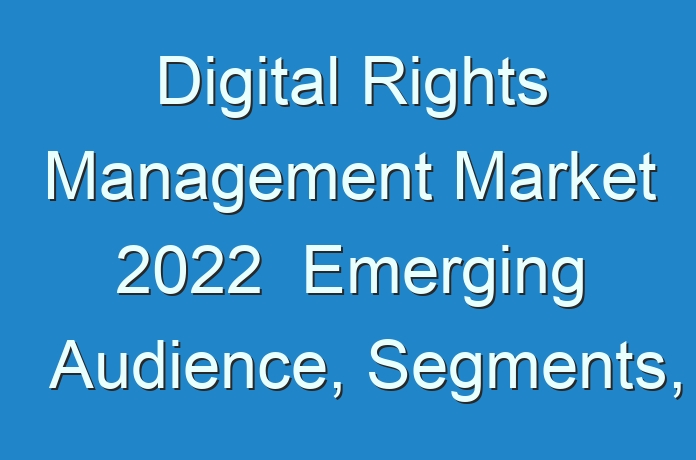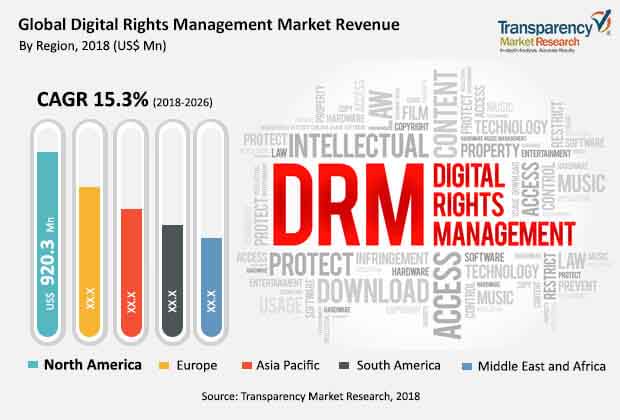
The global digital rights management (DRM) market is expected to expand at a significant pace during the forecast period, due to the rising demand of digital content security and management. Increasing digital piracy and thefts of digital content call for content security and management solutions. This factor is driving the global digital rights management market. Furthermore, the adoption of innovative revenue models and introduction of stringent policies and regulations by governments for protection of intellectual property (IP) from unfair usage and illegal competition are also driving the digital rights management market. However, currently, the DRM market is witnessing scarcity of unified DRM solutions. Thus, for complete security, end-users need to opt for multiple DRM solutions, resulting in high initial investments and high after-sales maintenance. Hence, scarcity of unified DRM systems is hindering the market. The market for digital rights management is projected to reach value of US$ 9,086.8 Mn by 2026, registering a CAGR of 15.3% during the forecast period.

Digital rights management (DRM) is a technology to protect ownership or copyright of the digital content by limiting what actions an authorized beneficiary may take in regard to the digital content. DRM enables the owner or publisher of the digital content to securely distribute precious content such as periodicals, enterprise-important data, photographs, books, educational material, and videos and to protect the digital content from thefts and piracy. Digital rights management is a software application or technology-enabled solution to control and monitor the unauthorized access of the digital content. DRM supports controlling, monitoring, organizing, and distribution of the digital content, with solutions deployed either on-premise or based on cloud or as a hybrid model. Industries that can benefit from digital rights management software are health care, BFSI, government, media & entertainment, and retail & consumers. Digital rights management is most commonly used in the media & entertainment industry. This is primarily due to high volume of the content generated, its wide online dispersion, and the growing number of media & entertainment companies, which increases the demand for enhanced control over images, videos, and audios from multiple sources.
However, with no typical DRM standard implemented, several DRM leaders have developed and promoted their own solutions. Presently, more than 20 applications are available in the market. If a customer wants to avail services of multiple companies, he/she has to purchase different versions of software and manage all of them separately. This is an inconvenience that could lead to DRM complexity and additional expenditure. Hence, requirement from consumers for a unified DRM solution, which can take care of all platforms of different vendors, is rising. However, lack of availability of such unified solutions is likely to hamper the market during the forecast period.
A key trend in the market is increasing demand for cloud-based solutions. This is because the demand for digital rights management solutions for a specific device and at a specific client location is raising the complexity for vendors. DRM systems need to serve a wide variety of devices popular among consumers. This leads to integrating, operating, and maintaining various DRM systems, resulting in increase in complexities and loss of revenues. However, cloud-based DRM allows the operator to outsource the DRM solution and offload various on-site operations to cloud. It also helps in freeing up valuable resources, which can be allocated to execute other significant tasks.
Cloud-based DRM is essential while tapping opportunities provided by video on demand (VoD), as the storage capacity offered on a mobile device is not sufficient to stream a high-quality video in real time. Cloud services is an efficient way to optimize DRM operations while availing a robust level of service. Transfer of license keys and several security functions from the client device to the server is simplified by using the cloud deployment model. This allows easier management, updates, and support for multiple DRMs, formats, protocols, and evolving business models. Due to these value additions, cloud-based solutions are likely to become popular. This is anticipated to provide substantial growth opportunities to the global DRM market in the near future.
The global digital rights management market has been segmented based on component, deployment model, and end-use. Based on component, the market has been segmented into software and services. The services segment has been sub-segmented into consulting, integration, and operation & maintenance. Based on end-use, the market has been divided into health care, BFSI, government, media & entertainment, retail & consumers, and others.
Ask for brochure:
https://www.transparencymarketresearch.com/sample/sample.php?flag=B&rep_id=25181
Among regions, North America is anticipated to witness rise in the consumption of digital media in the next few years. Increasing adoption of IPTV, OTT, and IoT technologies by consumers in the region is likely to boost the digital rights management market in North America in the next few years. The Asia Pacific digital rights management market is anticipated to expand at a higher rate during the forecast period, due to growing digitization in the region and rising demand to secure the digital content. Furthermore, the markets in Europe, Middle East & Africa, and South America are expected to expand significantly during the forecast period.
The digital rights management market is largely characterized by mergers and acquisitions and partnerships. For instance, as a part of its strategy, Vera Security, Inc. partnered with Canon Inc. in February 2018. This partnership would help enterprises to protect their business information and intellectual property from data leaks. Combining of solutions of both companies would allow customers to have access to a secure and trusted workflow platform. Some of the key players profiled in this report on the digital rights management market are Conax AS, Intertrust Technologies Corporation, Adobe Systems Incorporated, Oracle Corporation, Apple Inc., Microsoft Corporation, Locklizard Limited, Vaultize Technologies, Verimatrix, Inc., OpenText Corp., Seclore Technology, Vera Security, Inc., Vitrium Systems Inc., Dell EMC, Fasoo, Inc., Intralinks, Inc., and Nextlabs, Inc..
Read TMR Research Methodology at: https://www.transparencymarketresearch.com/methodology.html
Read Our Latest Press Release:
- https://www.prnewswire.com/news-releases/cloud-based-solutions-in-sales-performance-management-market-expands-scope-of-uptake-in-smes-worldwide-market-projected-to-clock-impressive-cagr-of-18-7-from-2019-to-2027-tmr-301240527.html
- https://www.prnewswire.com/news-releases/constant-process-automation-to-spur-strides-in-waterjet-cutting-machinery-market-thriving-demand-in-textile-industry-shapes-revenue-streams-tmr-301242291.html
- https://www.prnewswire.com/news-releases/advancements-in-automotive-engine-systems-centred-on-filtration-systems-underscores-growth-in-automotive-engine-air-filter-market-efforts-to-curb-greenhouse-gas-emissions-underlying-growth-factor-tmr-301242282.html





